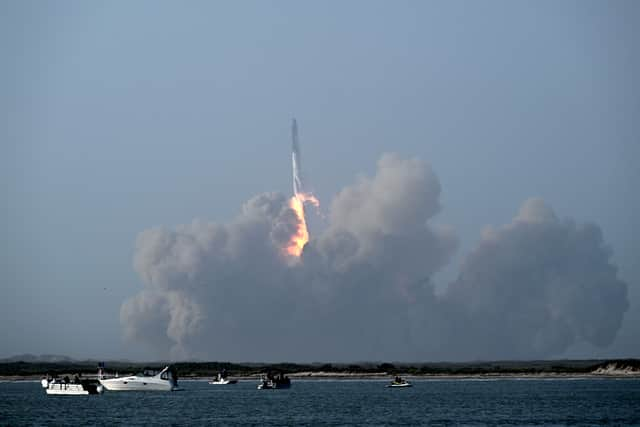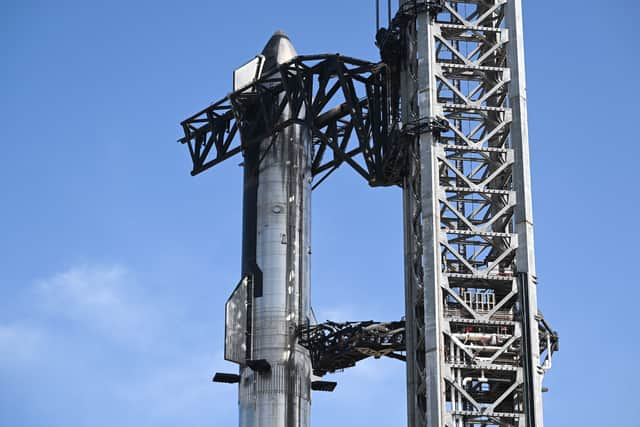SpaceX Starship launch: Elon Musk's 'reusable' rocket explodes minutes after successful liftoff
and live on Freeview channel 276
SpaceX founder Elon Musk shared news of his company's Starship launch on Twitter today, even though the multi-million dollar rocket exploded moments into its flight. The last minute delay to the test earlier this week was caused by a frozen valve.
Starship is the most powerful rocket yet created and the craft blasted off from Texas this afternoon on the first major test for the craft. The rocket is designed to be rapidly reusable, allowing for several launches into orbit to take place per day. Musk, whose latest high profile venture was to buy Twitter before tanking the social media app’s value from $44 billion to $20 billion, in his own estimation, is optimistic about his role in the future of space exploration.
Advertisement
Hide AdAdvertisement
Hide AdStarship is a major project that could be instrumental in the advent of space tourism. So far, fewer than 1,000 people have been to space, but Musk envisages using his Starships to take both astronauts and regular passengers into orbit and beyond.
But things didn't go entirely to plan with Starship’s launch, as the rocket experienced a 'rapid unscheduled disassembly' on its ascent. If you missed today's live launch, you can still watch the rocket take off online. This is everything you need to know about the Starship launch:


What is the SpaceX Starship?
The Starship, built by billionaire Elon Musk’s SpaceX company, is a 400 foot high rocket which is designed to be almost twice as powerful as any rocket to have launched before.
The rocket was being readied for its maiden launch - it was originally take off from the Boca Chica, Texas SpaceX launch site on 17 April.
Advertisement
Hide AdAdvertisement
Hide AdThe top segment of Starship has previously launched on short trips but it has never been tested with the booster, called Super Heavy, attached. Super Heavy was launched independently in February with its engines throttled at just half their maximum capability.
Musk has stated that the total cost of the Starship project is somewhere between $2 billion and $10 billion, which is quite a range, but the cost of launching the rocket is considerably cheaper than most space agency missions.
Whilst the cost of last week’s JUICE mission launch was around $165-220 million, the Starship launch is expected to cost just $10 million, and Musk believes that this cost will eventually fall to just $1 million per launch.
Additionally, the Starship is designed to be reusable, and Musk hopes to soon be able to send passengers into orbit several times a day.
Advertisement
Hide AdAdvertisement
Hide AdThe Starship is one of the first rockets to operate on an economy of scale, with Musk planning to build two new rockets each week with construction costs of around $20 million per rocket.


Why was the SpaceX Starship launch delayed?
A delay was confirmed today due to a pressurisation encountered during fuelling the first stage of the rocket. Musk took to to Twitter to blame a 'frozen pressurant valve' for the issue.
He added: "Learned a lot today, now offloading propellant, retrying in a few days".
What will happen on the Starship launch?
Today, the rocket and booster are expected to launch at 90%, or around 70 meganewtons, the equivalent to the force used to launch 100 Concorde supersonic airliners. Today’s test aims to send the Starship eastwards, with the Super Heavy booster separating over the Gulf and returning to near the coast of Texas where it will sink.
Advertisement
Hide AdAdvertisement
Hide AdThe Starship is expected to complete almost one full revolution of the Earth before coming down in the Pacific north of Hawaii 90 minutes after takeoff. The launch will be unmanned, but the Starship is able to carry 100 passengers.
If launch costs do come down to $1 million, then SpaceX would need to charge passengers just over $10,000 each to make trips profitable at full capacity.
Tempering expectations ahead of the launch, which is the first full test of the Starship and booster travelling together, Musk said: "It's the first launch of a very complicated, gigantic rocket, so it might not launch. We're going to be very careful, and if we see anything that gives us concern, we will postpone the launch," he told a Twitter Spaces event.
"If we do launch, I would consider anything that does not result in the destruction of the launch pad itself to be a win."
Advertisement
Hide AdAdvertisement
Hide AdWise words from Musk, as the launch wasn't a total success in that the rocket blew up on its ascent, something you really wouldn't want to happen if it had been a manned flight. Engineers explained that the rocket experienced a rapid unscheduled disassembly. However, they still called the test a success because the Starship successfully cleared the launch tower and did technically take off.
How can you watch the SpaceX Starship launch?
The Starship test flight was set to launch at 8am (1pm GMT) local time on 17 April, with a launch window of 150 minutes, however, the postponement was announced at 2.16pm GMT.
The launch was pushed back to between 2.28pm-3.30pm GMT on Thursday 20 - the launch happened on time, with lift off at 2.34pm. However, by 2.45pm, just 11 minutes into the planned 90 minute flight, the craft exploded.
A webcast of the launch covered the event - you can watch the launch on the SpaceX webcast, the official SpaceX YouTube channel and Twitter account.
Comment Guidelines
National World encourages reader discussion on our stories. User feedback, insights and back-and-forth exchanges add a rich layer of context to reporting. Please review our Community Guidelines before commenting.
